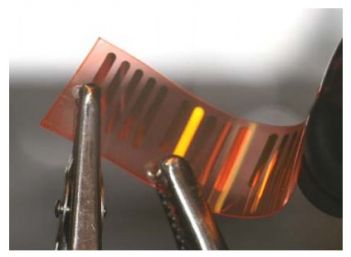One of the promises of OLED lighting is that flexible panels can be produced on the cheap using roll-to-roll processes. There is a lot of work towards this goal, but it hasn't been achieved yet. Now researchers from Sweden and Denmark have managed to produce light-emitting electrochemical cells (LEC) using an all-solution-based R2R fabrication process, in ambient conditions. They say that this process can be used to create large area panels too.

Polymer LEC panels are similar to PLEDs in structure, but in LECs the emitter polymer is blended with an electrolyte (e.g. LiCF3SO3 dissolved in PEO). LECs, which require only three layers, were first reported 15 years ago, but they suffered from very low lifetime and efficiency. But LECs are very easy to produce and so with steady improvements (mostly from choice of electrodes) LECs are now ready to enter the lighting market.
OLEDs still offer better performance, but at a higher production cost. Currently the LECs used in this research features about 10 lm/W and 5,600 hours of lifetime. They are using an all-fluorescent LEC, and they say that moving to phosphorescent materials can bring LECs up to par with OLEDs.
The three Universities involved with this research have launched a new company called LunaLEC to continue the research and developing of this technology and in the future commercialize it.
Comments
Thanks. Yes, I should have posted this as a source.


http://www.nature.com/ncomms/journal/v3/n8/full/ncomms2002.html